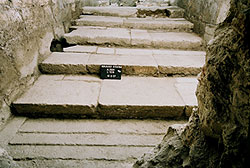
Remains of a terraced street that date to the period of Roman Jerusalem. Images courtesy of The Western Wall Heritage Foundation, photos Sando and Dino Mandria
Recently the remains of a terraced street were exposed that date to the period of Roman Jerusalem, when the city was called Aelia Capitolina (second-fourth centuries CE). The finds were discovered in the archaeological excavations that Alexander Onn of the Israel Antiquities Authority is conducting in the Western Wall tunnels for the Western Wall Heritage Foundation, in the entrance to the new women’s gallery.
The route of the street extends from west to east and it probably led to the Temple Mount itself. Today the street’s original axis is preserved by the Street of the Chain, which is built above it. The ancient street is amazingly well-preserved, delimited on both sides by walls built of ashlar stones, and is paved with large flagstones. The quality of the construction is extraordinary, as becoming an important city in the Roman Empire, and it seems it was built as part of the overall urban planning of the city.

The route of the street extends from west to east and it probably led to the Temple Mount itself. Images courtesy of The Western Wall Heritage Foundation, photos Sando and Dino Mandria
The recent archaeological discovery in the Western Wall tunnels constitutes a meaningful innovation and an addition of essential information to our understanding of the Temple Mount environs in Roman Jerusalem. And thus, contrary to prevailing opinion, it is becoming more and more apparent that after the destruction of the Second Temple the Romans, as conquerors of the city, also continued to preserve the importance of the Temple Mount and its surroundings as one of the main urban focal points of activity of the Roman city.
Numerous artifacts were discovered in the excavations: pottery vessels, glass vessels and dozens of coins, all of which date to the construction of the street and the period after it was abandoned.
Additional Articles ...